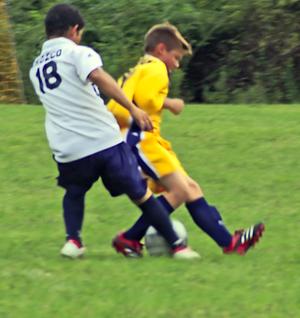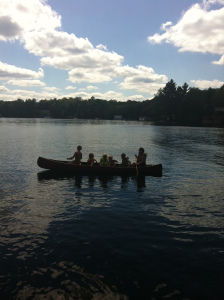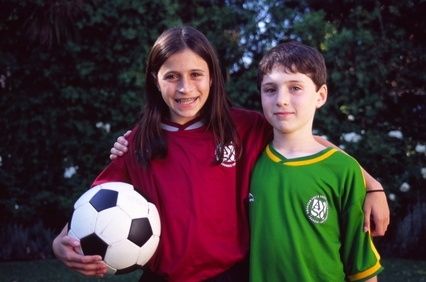The Negative Effects of Youth Sports
POSITIVE AND NEGATIVE EFFECTS OF SPORT
 Photo Credit youth soccer 072 image by John R. Amelia from Fotolia.com
Photo Credit youth soccer 072 image by John R. Amelia from Fotolia.com
Youth sports can offer positive and negative experiences for kids. For parents, it is important to focus on the positive benefits of youth sports so that the kids who participate get the most out of their experiences. These positive effects can help parents decide which program, if any, is right for their children.
Having Fun
One reason many parents allow their children to participate in sports, and why kids want to participate, is the chance to have fun. Sports teams allow kids another way to channel energy and to have that fun they desire. Parents should watch for signs that their children are no longer having fun and see if they may want to try a different sport.
Making Friends
Not only do kids want to have fun with sports, but they also want to make new friends and play with their current friends. When a child sees one of his friends playing a new sport, he may want to join that friend. The child also may want to try a new sport and end up making new friends as a result.
Learning New Skills
Youth sports programs give kids the opportunity to learn new skills related to the particular sport, as well as social skills. Kids also learn how to play by rules and respect decisions made by coaches and officials. Parents must remember that when the sport becomes more of a job than a play activity, kids can experience burnout. And when parents keep their child in only one sport, the child may not get to learn motor skills and social skills inherent in another sport or activity. Parents want their children to do well, but their sports experience needs to be well rounded.
Enhancing Self-Image
A better self-image, more confidence and more self-respect are other positive effects of youth sports. The President's Council on Physical Fitness and Sports says that developmental benefits of girls participating in sports are a higher self-esteem, higher self-confidence, a better body image and a reduced risk of chronic illness.
Getting Fit
Youth sports can also enhance the health and fitness of children who participate. Sports help to get kids out of the house, active and away from sedentary activities, such as video games. Youth sports give children the opportunity to start living a healthy and active life at a young age and helps to combat the rise in childhood obesity. When good habits like this are encouraged early, children are more likely to be healthy and fit adults
Read more: http://www.livestrong.com/article/106591-positive-effects-youth-sports/#ixzz2OCTwpX3O
We think that it is important to understand both the benefits and drawbacks of sport. For most of my sporting career, I have naively and narrowly focussed on the benefits. I understood that sports are associated with health benefits, and that they foster character development, but I failed to recognize the negative effects of sport. They exist as well.
 When I was younger, I focussed on the physical benefits. I wanted to be “as big as him and as fast as her.” I understood that practice would make me faster, and stronger. However, as we transition into adulthood, this focus turns into other health-related factors such as low blood pressure and a healthy body composition. What about the psychological, social, and intellectual benefits?
When I was younger, I focussed on the physical benefits. I wanted to be “as big as him and as fast as her.” I understood that practice would make me faster, and stronger. However, as we transition into adulthood, this focus turns into other health-related factors such as low blood pressure and a healthy body composition. What about the psychological, social, and intellectual benefits?
In the face of the happy, exciting, wonderful world of sport, it is common to turn a blind eye to the sports-related injuries, eating disorders, societies over-emphasis on outcome, and the aggressive behaviour of youth sport.
An article by Fraser-Thomas, et al. (2005) outlines the positive and negative experiences of sport with regards to four areas of development: physical health, psychological/emotional development, social development, and intellectual development. We believe in the importance of their findings, and summarize them here4:
 Positive youth experiences through sport:
Positive youth experiences through sport:
- Physical development: Physical activity develops motor skills, as well as strength and flexibility; important areas of normal growth and development
- Psychological/emotional development: Sport is an effective stress relief outlet, and is known to increase self-esteem. Sports present an opportunity for athletes to face and overcome challenges, and to have fun building new skills alongside new friends.
- Social development: Sports have been shown to develop a number of social skills, including: responsibility, cooperation, self-control, and assertion. Not only that, but sports have been shown to build citizenship, positive peer and adult relationships, and leadership skills.
- Intellectual development: Numerous studies show that involvement in physical activity is positively correlated with academic performance.
BUT, negative youth experiences and outcomes in sport:
- Physical development: Studies have found a link between sports and sport-related injuries, as well as eating disorders. Sports injuries are related to increased volume of training, and risk-taking behaviours expected of athletes. The literature also suggests that at increasingly younger ages, athletes, especially girls are becoming more concerned with their body image.
- Psychological /emotional development: As a society that places a lot of emphasis on outcome, there is excessive pressure to win. This emphasis on outcome can also result in the athletes perception of having poor abilities, a dis-attachment to their team, and a feeling of vulnerability in the presence of teammates.
- Social development: Due to the competitive nature of sports, and the social acceptance of aggressive behaviors in sport, acts of aggression are becoming more common in the youth sport setting.
The Positive Impact of Sports
Involvement in sports is an integral part of child development and teaches youth to lead active, healthy lives
while developing many of the fundamental skills necessary for a child to succeed. Let Kids Play (LKP) offers
parents and children the opportunity to overcome the barriers that may prevent youth involvement in sport. It is
recognized that financial and systemic barriers can play an inhibiting role on the involvement of youth in sport.
LKP will provide low-income and underprivileged youth with the financial means to help alleviate these barriers
and will work to facilitate the personal growth that is realized by youth through participation in sport.
A Canadian Council for Social Development study showed that participating in structured recreation positively
influenced young people’s physical and social development, as well as their civic behaviour and skills.1 A 2003
Sport Canada survey of 1005 Canadian youth, aged 12 to 21, found that their involvement in sports:2
Improved their health (99 per cent);
Helped them make friends (87 per cent);
Improved their feelings about themselves (85 per cent);
Helped them succeed at school (58 per cent);
Helped them become more active with their family (54 per cent).
Sport significantly enhances the quality of a child’s urban life.3 Numerous studies of social cohesion have
found that sport and community recreation play a key role in life in a city, and that recreation and sports
facilities contribute to a child’s integration into his or her community surroundings. Sport provides pleasure for
children and gives them the opportunity to meet new people and make new friendships, breaking the isolated
mould many low income and underprivileged youth fall under. Children develop a sense of self-belonging and
confidence through social cohesion. Participation in sport improves the development of peer relationships,
establishes the notion of trust and builds teamwork skills. 2Sports challenge children to excel physically and
mentally, and teach valuable skills such as leadership, hard work and perseverance which translate beyond
the playing field to all aspects of life, whether it be in the classroom, at work, or in the community.
The individual benefits of involving youth in sporting activities transcend into benefits for the community as a
whole. Participants experience a high degree of interaction with other individuals within their community, which
not only benefits the child, but such interactions also translate into the community's socio and economic
development.4 Thus, in addition to the personal benefits for the child, youth involvement in sports also has a
broader impact on the overall community. Participation in sport has a positive effect on reducing the
involvement and exposure youths may have to violence and unethical activity. Sports offer children a positive
alternative to idleness, which, if a child is consistently left without constructive activity, can often lead to
violence. A lack of activity and idleness can lead to a lack of understanding between different ethnic groups.
Sports help to eliminate these racial and cultural barriers by removing the separation between such groups
through healthy competition and the realization of shared goals.
Playing organized sports can be one of the best experiences for any young person with an interest in sports. A player can improve his skills, make friends and learn how to be part of a team. But the experience is not always beneficial. Young athletes can get hooked up with a coach who is more interested in his ego than helping a young person. Instead of forming friendships, a young person might feel isolated. Injuries can also result from tough competition.
Poor Coaching
The coach of a youth sports team has the ability to make the experience an enjoyable or miserable one for a young athlete. If a coach is in it to win games and championships rather than emphasize learning and enjoyment, then he is not the right kind of person to lead young people. Some coaches will act warm and friendly to young players when they perform well but then act like they barely know the youngster when they go into a slump. This can ruin a young person's attitude and make the experience painful.
Injuries
Organized youth sports take steps to keep young people from getting hurt while playing. But sports are not risk-free and even with the right techniques, players are going to get injured. This is particularly true when they play contact sports such as football, hockey and soccer. Injuries can also occur in basketball, baseball, volleyball and tennis. Youngsters who suffer serious injuries (knee, shoulder, back and neck) might be hesitant to take the field in competitive situations again.
Parental Pressure
Sometimes the parents of athletes put undue pressure on young performers. Some might be blatant and provide specific expectations. "I expect you to get at least two hits tonight," a father might say because he hopes to bring out a good performance. Others might indicate that the family name is on the line and issue a threat. "You better not do anything to embarrass me," could be a parent's last words before their child takes the field. Those are harmful words. Even if the child does perform well after hearing those words, all he might feel is relief. He won't feel any of the joy that these sports are designed to promote.
Read more: http://www.livestrong.com/article/95532-negative-effects-youth-sports/#ixzz2OCTFS1Ws
The Negative Effects of Youth Sports
X

Stan Mack
Stan Mack is a business writer specializing in finance, business ethics and human resources. His work has appeared in the online editions of the "Houston Chronicle" and "USA Today," among other outlets. Mack studied philosophy and economics at the University of Memphis.
By Stan Mack, eHow Contributor

Having fun will prevent kids from burning out.
Children love sports, but since they are still developing physically and mentally, they may encounter some negative effects. If possible, choose an organized-sports league that actively promotes healthy attitudes and lifestyles among its members. With a supportive environment and the right encouragement, you will be able to minimize the chances of either physical or mental injuries to your child.
Injuries
o A 2009 report published by the National Institutes of Health (NIH) outlines some common risks of injuries for children in sports. These include sprains and strains (muscle, ligament and tendon injuries), growth plate injuries (damage to areas of tissue growth near the ends of bones in growing children), repetitive motion injuries and heat-related illnesses. To avoid these injuries, the NIH recommends researching the sports organization you enroll your child in to make sure it has officials and coaches trained in CPR and first aid. Also, the NIH recommends that your child have all necessary protective gear. Finally, make sure your child stays hydrated and follows the safety rules of the sport.
Early Burnout
o Competitive sports may be too stressful for children, according to a report by James White and Gerald Masterson, Ph.D. on FamilyResource.com. They cite research that shows that children may experience "burnout," a stress reaction that results from overtraining and an environment that tells children to "play at all costs." The authors of the report advise parents to avoid pressuring children to specialize in just one sport, as this may make children feel they must perform rather than have fun. Instead, allow children to play all the different sports they wish. Also, create an environment for your children that decreases the competitive aspect of sports in favor of its fun and enjoyable aspects.
Inadequate Nutrition
o Nemours is a non-profit organization that provides information about child health and safety via its website KidsHealth.org. It warns parents that children in sports use high levels of energy and have an increased chance of injury, so it is important that they receive proper nutrition. The organization offers dietary advice and guidance for parents of children who play sports. If possible, ask a dietitian or nutritionist about what nutritional risks your children face and to help you construct a diet that supplies your children with all the nutrients they need.
Read more: The Negative Effects of Youth Sports | eHow.com http://www.ehow.com/list_6132457_negative-effects-youth-sports.html#ixzz2OCWk4iV0